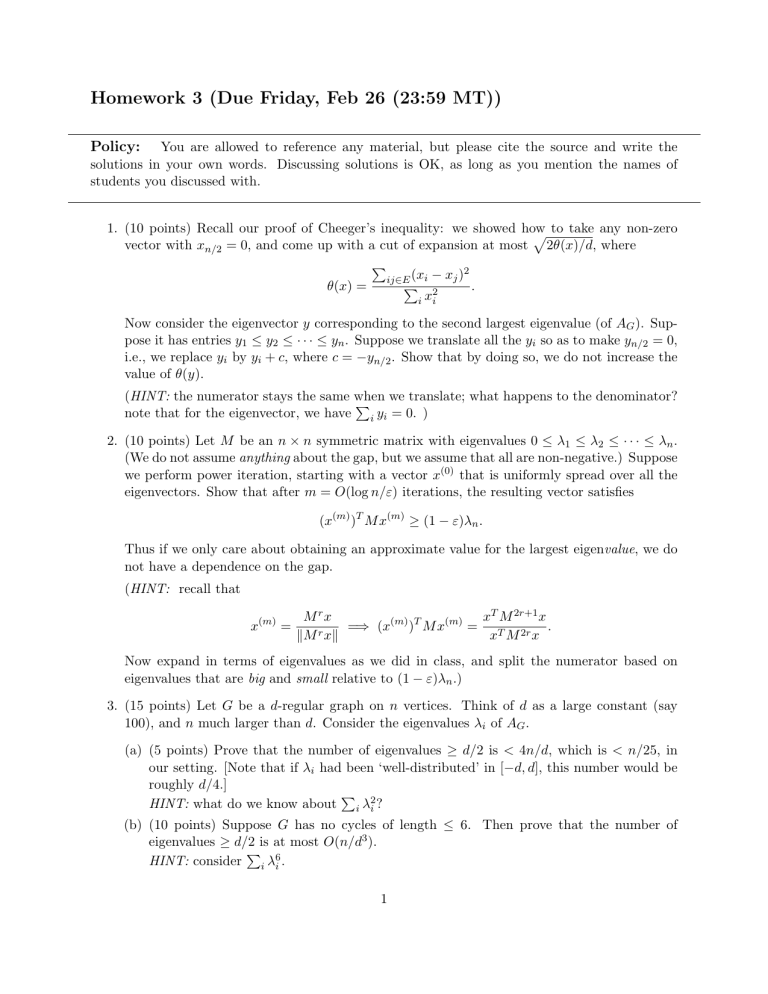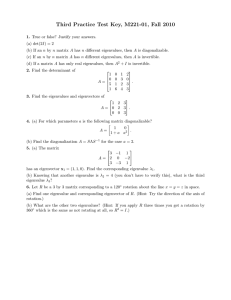Homework 3 (Due Friday, Feb 26 (23:59 MT)) Policy:
advertisement

Homework 3 (Due Friday, Feb 26 (23:59 MT)) Policy: You are allowed to reference any material, but please cite the source and write the solutions in your own words. Discussing solutions is OK, as long as you mention the names of students you discussed with. 1. (10 points) Recall our proof of Cheeger’s inequality: we showed how p to take any non-zero vector with xn/2 = 0, and come up with a cut of expansion at most 2θ(x)/d, where P 2 ij∈E (xi − xj ) P 2 . θ(x) = i xi Now consider the eigenvector y corresponding to the second largest eigenvalue (of AG ). Suppose it has entries y1 ≤ y2 ≤ · · · ≤ yn . Suppose we translate all the yi so as to make yn/2 = 0, i.e., we replace yi by yi + c, where c = −yn/2 . Show that by doing so, we do not increase the value of θ(y). (HINT: the numerator stays the same when P we translate; what happens to the denominator? note that for the eigenvector, we have i yi = 0. ) 2. (10 points) Let M be an n × n symmetric matrix with eigenvalues 0 ≤ λ1 ≤ λ2 ≤ · · · ≤ λn . (We do not assume anything about the gap, but we assume that all are non-negative.) Suppose we perform power iteration, starting with a vector x(0) that is uniformly spread over all the eigenvectors. Show that after m = O(log n/ε) iterations, the resulting vector satisfies (x(m) )T M x(m) ≥ (1 − ε)λn . Thus if we only care about obtaining an approximate value for the largest eigenvalue, we do not have a dependence on the gap. (HINT: recall that x(m) = M rx xT M 2r+1 x (m) T (m) =⇒ (x ) M x = . kM r xk xT M 2r x Now expand in terms of eigenvalues as we did in class, and split the numerator based on eigenvalues that are big and small relative to (1 − ε)λn .) 3. (15 points) Let G be a d-regular graph on n vertices. Think of d as a large constant (say 100), and n much larger than d. Consider the eigenvalues λi of AG . (a) (5 points) Prove that the number of eigenvalues ≥ d/2 is < 4n/d, which is < n/25, in our setting. [Note that if λi had been ‘well-distributed’ in [−d, d], this number would be roughly d/4.] P HINT: what do we know about i λ2i ? (b) (10 points) Suppose G has no cycles of length ≤ 6. Then prove that the number of eigenvalues ≥ d/2 is at most O(n/d3 ). P HINT: consider i λ6i . 1 4. (5 points) Show that the eigenvalues of the adjacency matrix of a bipartite graph are symmetric about the origin, i.e., if λ is an eigenvalue, then so is −λ. [This is one of the few spectral properties that only holds for an unnormalized adjacency matrix.] HINT: Start with an eigenvector for eigenvalue λ, and construct one for −λ. 5. (10 points) Suppose a king moves randomly (picks one of the allowable moves) on an 8 × 8 chessboard for N steps, where N is large (think of it tending to ∞). What is the expected number of times the king enters (a) square (1, 1) (b) square (2, 2) and (c) square (4, 4). 2








